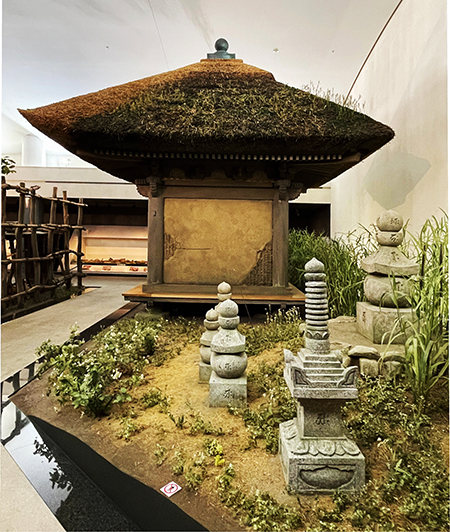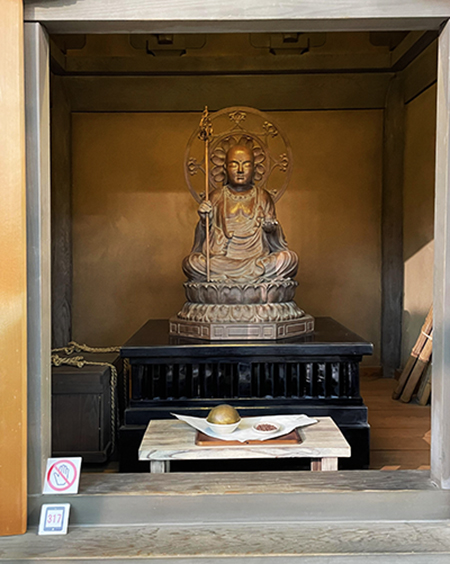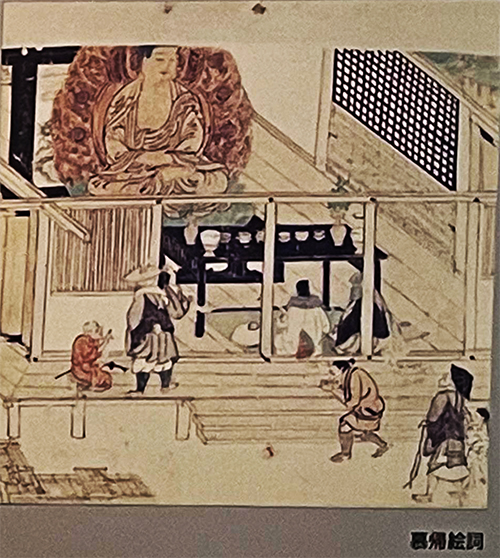


鎌倉〜室町の歴史時間の「門前市」という性格の中世都市、草戸千軒は土地支配や宗教支配などの権力機構の表情を持っていない、一種のアジール空間。たぶん畿内地域での堺と似た性格の境界都市なのだろうと思いますが、そういう存在には庶民の生き方志向性が表現されるていると思える。
商工という成立の要件に沿って都市の空間や「街割り」は生成された。そういう都市計画のなかで「やはりそういうことか」と腑に落ちるのが、この宗教建築「御堂」。
博物館の調査研究発表によれば「祈る」と題して以下のようなくだりがある。
〜草戸千軒からは石製・木製の塔婆、法華経を書写した杮(こけら)経および位牌・懸仏(かけぼとけ)が出土している。社会が混乱し、不安な生活を送っていた中世民衆の神仏信仰の一端がうかがえる。〜
とされていました。人間はかならず死ぬ。そのことが人間の精神世界をつよく規定することは当然。親子関係など、いのちに関わる情念を外化させ、形象化することが社会規範の最重要なことがらと意識された。
古代以来日本では、古墳という形式で死者を弔う伝統が生きていたし、一般民衆も共同墓として葬られ祀られ続けてきた。そういうなかで仏教はアジア世界から日本社会に導入されたけれど、ほかの地域以上に日本社会では人びとの精神性の奥底まで浸透していった。
存立基盤自体が社会の「隙間」的な中世都市で、いわば自然発生的にこういう人間の死生にかかわる建築施設が建立された。もちろんある特定の経済的リーダーのような市民存在があって、その喜捨のような負担をきっかけとして、多くの賛同者が集合してこういう建築空間成立に至ったものでしょう。
この草戸千軒と似た都市性格を持っていたと推測される同じ瀬戸内海交易圏の姫路「英賀千軒」に於いては、一向宗の布教活動が大成功して「英賀御堂」という民衆の結集の象徴が成立した。都市としては自然災害によって消失したこの草戸千軒に於いても、そうした機縁の萌芽はあったことになる。この「英賀御堂」は秀吉の英賀攻めで焼失したけれど、現在も亀山御堂として移転し存続している。
日本に於いてはこういうアジール空間・商工都市というのは、宗教という存在を大きな媒介として相互利用してきたことが、こうした遺構からは見えてくる。

宗教の中でも、いわば宗派間でその教義には違いがあり、都での権力者との強い連携を目指した宗教とはまったく別に「民衆の救済」を目指した新宗教がこの時代、大いに勃興した。
いまのところ「御堂」という名称しか明らかにされていないけれど、あるいは英賀御堂のように特定宗教会派の拠点化という発展形態もあり得たのかも知れない。
中世の人々の死生観、精神のありかのなにかが示されているのでしょうね。合掌。
English version⬇
[Citizens’ Own Religious Architecture “Mido” – Kusado-Senken 2023 Revisited – 11
The affinity between the city of commerce and religion. The economic activity of trade seems to have been socially compatible with the interrelationship with religion.
A medieval city in the character of “gate city” in the Kamakura – Muromachi historical time, Kusado-Senken is a kind of azir space that does not have the expression of power structure such as land rule or religious rule. Perhaps it is a boundary city with a character similar to Sakai in the Kinai region, but such an existence is an expression of the lifestyle orientation of the common people.
It can be seen that the urban space was created in accordance with the requirements for the establishment of commerce and industry. In the context of such urban planning, the religious building “Godo” can be seen as “so that’s what it is,” as the museum’s research study says.
According to the museum’s research presentation, the following passage is found under the title of “Prayer.
〜Stone and wooden pagodas, copies of the Lotus Sutra, tablets, and kakebotoke have been excavated from Kusado-Senken. These objects suggest a part of the medieval people’s belief in the gods and Buddha during a time of social turmoil and uncertainty in their lives. 〜The site was considered to be a “temple of the gods”.
The people of the medieval period were said to have believed in the gods and Buddha. Human beings will inevitably die. It is only natural that this fact should strongly define the spiritual world of human beings. The externalization and embodiment of life-related emotions, such as parent-child relationships, was recognized as the most important social norm.
Since ancient times, the tradition of mourning for the dead in the form of kofun (burial mounds) has been alive in Japan, and the general public has also continued to worship the dead in communal graves. Buddhism was introduced to Japanese society from the Asian world, and it penetrated deeper into the psyche of the Japanese people than in any other region.
In medieval cities, where the very foundation of existence itself was a “gap” in society, these architectural facilities, which were related to human life and death, were erected spontaneously, so to speak. Of course, there must have been a certain economic leader, a citizen, whose generous donation must have triggered a large number of supporters to establish this kind of architectural space.
In Eiga Senken in the Himeji area, which is also in the Seto Inland Sea trading zone, the missionary activities of the Ikkyu Sect were so successful that a symbol of the people’s rally called “Eiga Godo” was established, but even in this Kusado Senken, which was destroyed by a natural disaster as a city, the germ of such an opportunity Eiga Godo” was a symbol of the people’s rallying. This “Eiga Gōdo” was destroyed by fire during Hideyoshi’s attack on Eiga, but it has been relocated and continues to exist today as the Kameyama Gōdo.
These remains show that in Japan, such asyl spaces and commercial and industrial cities were used interchangeably, with religion as a major mediator.
Among religions, there were differences in doctrines among sects, and new religions that aimed to “save the people” emerged in this period, completely different from those that aimed for strong alliances with the authorities in the capital. Although only the name of the temple, “Godo,” is known at this point, it may have been a base for a specific religious sect, as was the case with Eiga Godo.
It may indicate something about the medieval people’s view of life and death and the state of their spirit. I bow my head in prayer.
Posted on 12月 23rd, 2023 by 三木 奎吾
Filed under: 住宅マーケティング, 日本社会・文化研究







コメントを投稿
「※誹謗中傷や、悪意のある書き込み、営利目的などのコメントを防ぐために、投稿された全てのコメントは一時的に保留されますのでご了承ください。」
You must be logged in to post a comment.